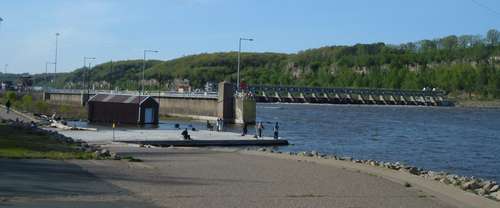Hastings Hydrokinetics Project raises more questions than answers

A new project is proposed to supplement the hydroelectric output of the existing dam, pictured here, in Hastings.
Should an untested hydroelectric technology with unknown impacts be given a 25-year license to operate in a National Park? That question is at the heart of a debate currently unfolding in Hastings, as the Associated Press reported late last month.
Hydroelectric dams like the one in Hastings have long produced power using the force of falling water. But a new technology called hydrokinetics looks to produce energy from the force of the standard river flow.
The proposal in Hastings is to suspend a large turbine beneath a barge, anchored just below the Hastings dam. The turbine would have three 12 foot blades rotating about once every 3 seconds.
Compared to the existing hydropower facility, the energy output of the turbine would be quite limited. The turbine is expected to add just 35 kilowatts of energy production capacity to the existing 4,400 kilowatts at the Hastings dam.
The project is proposed by Hydro Green Energy of Houston, which will split proceeds from the project with the City of Hastings. A second turbine might be added later.
Champions of the hydrokinetics project point to it as a way of reducing our contributions to climate change. But others express concern about rushing headlong into such projects with little understanding of the projects ecological cost to the river particularly given its place in the 72-mile long Mississippi River National Park in the Twin Cities.
The project would have no significant impact on the environment, according to a September 2008 assessment of the Federal Energy Regulatory Commission (FERC), which is responsible for licensing hydropower projects.
FERC further decided the project was not inconsistent with the Park Services Comprehensive Management Plan for the Mississippi River Park through the Twin Cities. By reaching those conclusions, FERC was able to award a license to the hydrokinetic project, at least for now.
But the National Park Service is challenging FERCs basis for its conclusions, given how little experience anyone has with the hydrokinetic technology involved in the project.
We fully support the notion of the development of sustainable, green energy, said Paul Labovitz, Superintendent of the Mississippi National River and Recreation Area (MNRRA). However, if this projects impacts land or aquatic species and poses major threats to safety and recreation, it isnt green or sustainable within the context of a National Park.
And in response to FERCs assessment, the Park Service has more questions than answers about the project and how FERC was able to reach its conclusions. What is the potential scale and severity of injury to fish, diving birds, and bald eagles in the project turbines? What is the expected impact on specific endangered species of water life?
Where would the barge move and turbine be removed in the event of flooding? What can be done to protect the safety of the thousands of boaters who pass by the site each year? What kind of noise will be generated by the project? How will the project impact habitat and restoration work NPS has helped plan and execute in the area?
Questions such as these are given short shrift in FERCs analysis, the Park Service says. On January 12, the Department of the Interior filed a request for rehearing of the hydrokinetic projects license.
The request for rehearing asks FERC to change the project license from a 25-year duration to a test period of 3-5 years. The request also asks FERC to be more specific and forceful about the data and analysis on which it based its conclusions.
Nationwide, hydrokinetic boosters are positioning the technology to take off quickly. According to the River Management Society, over 160,000 hydrokinetic turbines have been proposed in various locations on the Mississippi, Missouri, and Ohio Rivers.
The technologys ascent has been so rapid that until last year, the Federal Energy Regulatory Commission (FERC) lacked a permitting procedure for the projects. Under the new procedure, projects have typically been required to go through a 3-5 year trial phase before full licensing could occur.
But FERC didnt require a trial phase in Hastings, where the project was initiated before FERCs new rules were formalized. And a 25-year license for an untested technology is especially unusual for a National Park.
Locally, park staff are hopeful parallel events occuring in other cities bode well for a more careful examination of hydrokinetics in Hastings.
On November 28, FERC rejected a similar application for a hydrokinetic project in the Golden Gate National Park. The rationale? It was insufficient to support [FERCs] environmental analysis.
Which, of course, is exactly what the National Park Service has been saying all along about the project in Hastings.